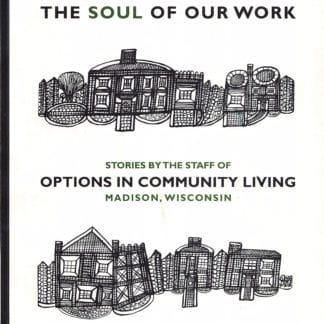Why Ontario doesn’t need ‘more’ institutionalized supports
for seniors and others living with disabilities
Note: IFCO is an amazing resource with cutting edge current comments – and deep history. Use it.
For decades the Individualized Funding Coalition for Ontario (IFCO) along with many other provincial organizations, service agencies, people and families have supported the closure of institutions for people with disabilities. They have done this knowing there are other options that can provide what is required for people to be successfully supported. This meaning: viable alternatives and supports in people’s homes, neighbourhoods, and communities.
We have seen this to be successful with people with disabilities. We know it can also be successful with seniors and others who by default have ended up in long term care homes. It would take intention, commitment, and investment directed to other approaches. It is doable. It has been demonstrated in other locales and countries.

Individualized, personalized support created and directed by the person (with support from their family or friends if needed) is the opposite to institutional care environments. Currently millions of unpaid caregivers in Canada are ‘holding up our systems of support’ by contributing more than $25 billion in unpaid labour to our health system (Hollander et al, 2009). Reports over the years have shown us that others receiving expensive government funded supports, people living in long term care facilities, are not experiencing good health and well-being, dignity, a sense of self-worth, and control over their lives. The Individualized Funding Coalition for Ontario would be remiss not to add our voices to others in saying, “There is a better way”.
Every citizen in Ontario from young to old who requires extra assistance — be it activities of daily living, personal and/or medical support, supports to live life exactly where one needs to be at whatever stage or age – everyone deserves a better way. That most importantly includes our elders, whose presence alone is a gift to their families, friends, and caregivers.
After decades of contribution through work, raising families, volunteerism, and paying taxes faithfully — think about how we reward Seniors. We do it with very minimal home care support (which before the pandemic required coordination time by loved ones to the point of exhaustion.) When that model doesn’t work – when home care is not enough, and family can’t do it anymore – ‘we’ offer a waiting list to a roof over one’s head in an institution – a nursing home/long-term care home. This speaks for itself with what we know about the reality of long-term care homes in Ontario.
Many of us would do well to understand why a system that has let our elders down is being supported and maintained to the fullest, at the expense of other person-centered, individualized and responsive home care options. To learn more about what is keeping institutional long-term care models alive in this province check out the Information Alert by Seniors for Social Action Ontario (SSAO) highlighted here.
How vested interests in long term care maintain the current system
Read this short excerpt from the report that emphasizes a tragic truth: that voices of older adults and their calls to keep them OUT of institutions is missing! “Any reform of long-term care must emphasize the voices and lived experience of older adults, especially with research indicating that over 90% of older adults have made it clear they wish to age in their own homes and communities (Home Care Ontario, 2020). Neither argument made by the main protagonists in long term care addresses what seniors themselves have been saying for decades – both inside and outside of these institutions. They never want to enter one, and “I want to go home!” or “get me out of here!”
Start at the beginning of the report: Many have asked the question, “why are problems in long-term care so entrenched”? It is a reasonable question since not much has changed for long term care residents in over 40 years. This report explains it. To keep reading the full report click here: SSAO – How vested interests … maintain the current system
Alternatives to Institutions Series: Denmark – the gold standard in long term care:
How Denmark’s approach is different from Ontario’s
Other countries are doing much better than Ontario in offering enhanced home care, as well as smaller community homes. One of those countries is Denmark.
In the Seniors for Social Action Ontario’s series “Alternatives to Institutionalization” their newest paper compares the Denmark system of caring for seniors to the Ontario system. This research paper demonstrates how far behind Ontario is in supporting seniors in a more humane manner. Seniors in Ontario want to be supported to age-in-place, yet Ontario continues to support the institutional model of care. Ontario needs to study and learn from the success of the Denmark system. Click here to read the paper: Denmark – The Gold Standard in Long Term Care
About Seniors for Social Action Ontario: If you are 55 years or older, or even a younger ally for your elders, and you want to learn more about Seniors for Social Action Ontario (SSAO) follow this link: https://www.seniorsactionontario.com/
A Message from the Co-Chair for 2021 Individualized Funding Models Do Work
By Yona Frishman,
It is with great excitement that I share with you my recently acquired knowledge about a comprehensive study on individualized funding.
The study is called:
Individualized funding interventions to improve health and social care outcomes for people with a disability: A mixed‐methods systematic review
- This study is a review of 73 studies on individualized funding for people with disabilities.
They include 4 quantitative studies, 66 qualitative and 3 based on a mix-methods design. - The data refers to a 24 – year period from 1992 to 2016, with data for 14,000 people.
- The review authors searched for studies up to the end of 2016. Studies that were carried out in Europe, the US, Canada and Australia.
- This review was published in January 2019.
The aim of this review was to examine the effects of individualized funding on a range of health and social care outcomes. It also presents evidence on the experiences of people with a disability, their paid and unpaid supports and implementation successes and challenges from the perspective of both funding and support organizations.

The review provides an up-to-date and in-depth synthesis of the available evidence over 25 years. It shows that there are benefits of the individualized funding model. This finding suggests that practitioners and funders should consider moving away from skepticism, towards opportunity and enthusiasm. Policy makers need to be aware of the set-up and transitionary costs involved. Investment in education and training will facilitate deeper understanding of individualized funding and the mechanisms for successful implementation. Picture from Pixabay
The World Health Organization estimates that 15% of the world’s population live with a disability and that this number will continue to grow into the future, but with the attendant challenge of increasing unmet need due to poor access to health and social care (WHO, 2013).
Historically, the types of supports available to people with a disability were based on medical needs only. More recently, however, the importance of social care needs, such as keeping active and socializing, has been recognized. There is now an international policy imperative for people with a disability to live autonomous, self determined lives whereby they are empowered and as independent as possible, choosing their supports and self‐directing their lives . . . (click to keep reading)
__________________________________________________________________________



